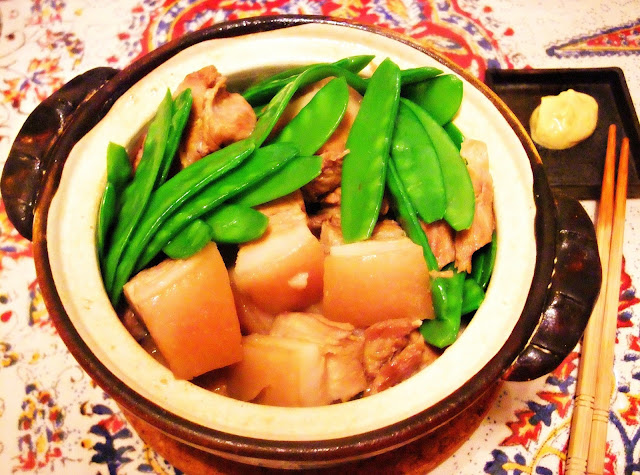March third marks a celebration day of sumptuous prized pork belly in Korea. It is honoured on this day for it's name-- the first part of the Korean word for pork belly Samgyeopsal, is sam 삼 which means three, so third month, third day- how appropriate and fun! And oh what fun with a double dose on special... It also happens to be another important day in Japan, paying tribute to Girls' Day or Doll's Day Hinamatsuri (雛祭). To give nod to both cultures, I made a dish of Japanese braised pork belly (kakuni) in a clay pot. This is different than the popular Chinese red-braised pork belly (dong-po), in that you don't cook the pork in the accompanying sauce for hours but rather boil first the pork until tender simply in salted water and then cook in the sauce for a short time to render a light delicate flavour. Kakuni is a recipe that originated in Japan’s south-- lightly seasoned but sweet and gelatinous, its rich pork flavours benefit from being offset with the sharpness of mustard for dipping.
Makes 4 to 6 servings
2 lbs. slab pork belly (without bones), rinsed with cold water and patted dry
1/2 tsp. salt
handful of snow peas, peeled
1 cup water
1/4 cup sake
4 Tbsp. or 1/4 cup sugar
2-1/2 Tbsp. soy sauce
1 Tbsp. mirin sweet cooking sake
Japanese hot mustard, or Dijon mustard for dipping
NOTE: Choose pork belly that has glossy pale pink colour and its fat firm and white.
Place pork in a pot and fill with water to cover and add salt; bring to a boil. Reduce heat to medium-low and continue to cook for about two hours while occasionally adding water until the pork becomes tender enough for a bamboo skewer to pierce through fairly easily. Let stand until cool. Add the snow peas to the pork broth and let simmer for a few minutes until crisp-tender; remove peas onto a plate. Let the pork broth cool, pack it and refrigerate or freeze for later.
 |
| Saving the pork broth for soup for Saturday's Chinese hot pot! |
Rinse the pork in cold water, eliminate any debris and excess fat, and cut into bite-sized pieces.
Add water, sake, sugar and pork in a pot or clay pot (as I'm doing) and bring to a boil. Then add the soy sauce and cover with a drop-lid, otherwise, cook slightly covered with regular lid. When the liquid is reduced to about half, turn up the heat to high, and pour in the mirin in a circulating motion.
 |
| Japanese sake bought in supermarkets are salted. For unsalted sake used for cooking I went for the cheapest drinking sake at the wine store. |
Add the snow peas to the pot, give it a stir with the sauce and pork; and it's ready to serve.
Tender morsels of meat and its gelatinous texture nearly melts in the mouth, with snow peas that add colour and slight crunch. Served dipped with mustard the sharpness complements the pork's natural richness bathed in a light delicate sweet broth. Perfect served with steamed rice.
See here for more pork belly recipes in Korean- and Chinese-styles, and of course we can't not mention one of the king of pork belly preparations, Siu Yok (Crispy Roasted Pork Belly).








No comments:
Post a Comment
Note: Only a member of this blog may post a comment.